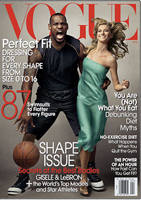Archive for March, 2008
MSNBC Video: Is the Vogue Cover Racist?
Posted in Academic, Contemporary Flashpoint, Contemporary in context, Political on 28 March 2008 by spitztengleThe Fallout in Public Response: “Much Ado About Nothing”?
Posted in Academic, Contemporary Flashpoint, Contemporary in context on 27 March 2008 by spitztengle Over at SportsFilter the SpoFites are debating the merit in any racist interpretation of the Vogue cover. Overwhelmingly, the consensus appears to be that this is “much ado about nothing.” LeBron okayed the image. Gisele signed off on it. Which must mean that we’ve got a collective of all-too-sensitive zealots who want to make an issue out of nothing.
Over at SportsFilter the SpoFites are debating the merit in any racist interpretation of the Vogue cover. Overwhelmingly, the consensus appears to be that this is “much ado about nothing.” LeBron okayed the image. Gisele signed off on it. Which must mean that we’ve got a collective of all-too-sensitive zealots who want to make an issue out of nothing.
Follow the debate. Throw in your two cents. In a day or two I’ll have a follow-up post to help “make sense” of this all from a critical, but realistic, cultural studies point-of-view. Until then … do join in on the discussion, whatever your viewpoint may be.
Dig it!
Gone are the Peacemakers
Posted in Academic, Contemporary Flashpoint, Contemporary in context on 26 March 2008 by spitztengleIronically, this controversy (err, flashpoint?) erupts just as I’m reading Scripting the Black Masculine Body by Ronald L. Jackson (2006). Which means that my first point is going to qualify this response as an admitted disourse analyst who does read this image (and the bodies therein) as text. I do this in response to Jackson’s critique that reads:
In reading bodies as text, the discourse analyst does the interpreting of the written text with little to no regard for how and why the text was initially written (p. 53).
Jackson goes on to then espouse, “in a bit more sophisticated terms,” the nuances of the analysis of corporeal inscription, which he insists involves a more in-depth, “critical focus on both the historical and contemporary manifestations of body politics” (p. 53). Its principle concern, he says, lies with the intent as well as the underlying motivations for the inscription–for the act of writing the text–which, in this case, would be the staging of the photograph.
But let’s put that rather semantic debate over whether or not analysing the discourse or the inscription is more valid in this case (obviously, you know where I stand on this issue–once again we’re confronted with someone who doesn’t grasp the scope and complexity of discourse analysis), and look at the act, motivations, and intentions behind the “inscription” of this text.
First of all, Vogue is 100% unsurrepticiously seeking to capitalize on the celebrity status of the two cover models. As Vogue spokesperson Patrick O’Connell states, the magazine is seeking “to celebrate two superstars at the top of their game.” Moreover, they are also wanting to maximize the benefits from having the first black male on its cover (only the third male to grace the cover in its history. If I’m not mistaken, following Richard Gere and George Clooney (both with the supposed intent to pander to Vogue‘s gay readership)). Exploit James’s marketability? Why not? Nike is doing it (as is Coke, Bubblicious, and Juice Batteries). This isn’t new. “[T]he Black body is treated as cultural capital and commodified in the popular marketplace” (Jackson paraphrasing Cornel West (1993), 2006, p. 73). Realistically, “[i]f one surrenders capitalism, one must also concede the exploitation of Black bodies and the negative projections that drive this exploitation” (p. 73). As a result, black bodies will “continue being commodified in a number of ways throughout everyday [North] American life, and this practice is mirrored in popular culture” (p. 73).
Secondly, the photographer of this cover isn’t shy about taking “controversial” shots. In fact, it’s how she gained such notoriety. Annie Leibovitz, as a contributor to Vanity Fair, garnered the reputation of being bold and unafraid after such provocative pics as Demi Moore’s pregnant nude  and Whoopi Goldberg in a tub of milk. So let’s not even try to pretend that this imagery is “innocent.” The analyst quoted in the article hits it right on the head. And since magazines with such high profiles as Vogue don’t rush to print their covers (especially ones with potential for negative fallout), this had to be intentional–planned and deliberate.
and Whoopi Goldberg in a tub of milk. So let’s not even try to pretend that this imagery is “innocent.” The analyst quoted in the article hits it right on the head. And since magazines with such high profiles as Vogue don’t rush to print their covers (especially ones with potential for negative fallout), this had to be intentional–planned and deliberate.
Finally, something must be said to those who don’t see any potentially racist overtones, or to LeBron James himself who told an interviewer, “Who cares what anyone says?” Speaking to the “hypersensitivity to race” in [North] America, simply ask yourself this: who do you want to win in the US Democratic Convention, and why? Sex/Gender and Race are still very much at the forefront of contemporary thought and politics. Unfortunately (yes, for black folks, but also for us all), if this imagery is what is used to sell magazines, the “suggestion [remains] that the worth of Blacks lies in their ability to entertain via sports, dance, comedy, drama, and so on” (Jackson, 2006, p. 58). But rather than point fingers at who is to blame, the least we can do is to consider all of the reasons why this imagery–these texts–can still be read in this way. Why does the lascivious image of black men–on black bodies in general–remain so “prominent in popular media” (p. 4)?
Because people buy it. It sells–period.
